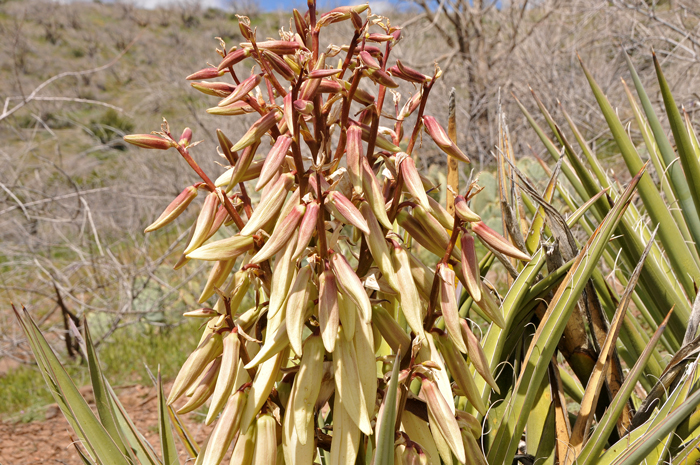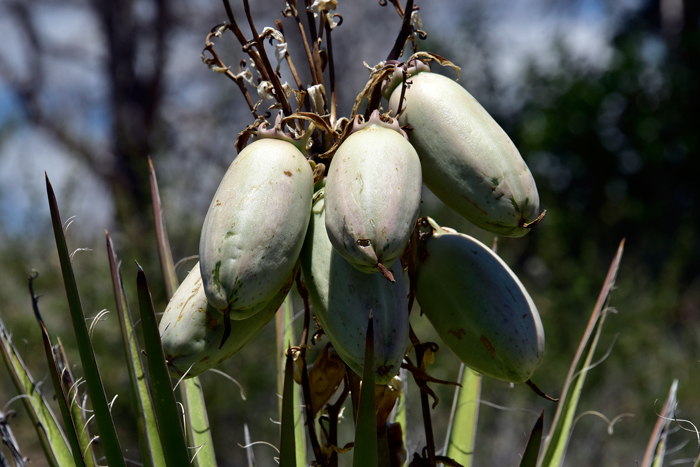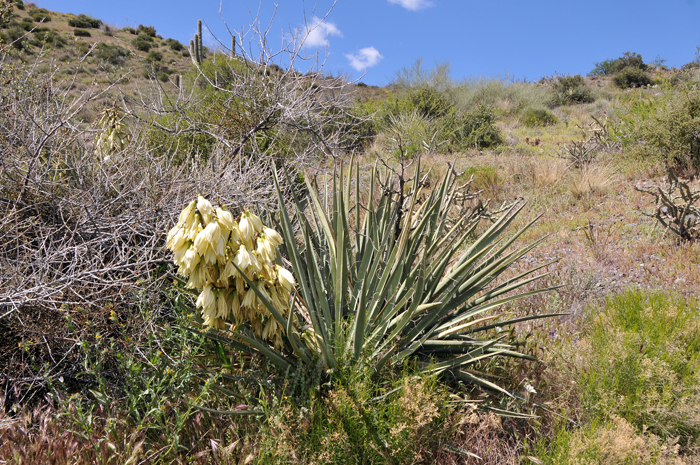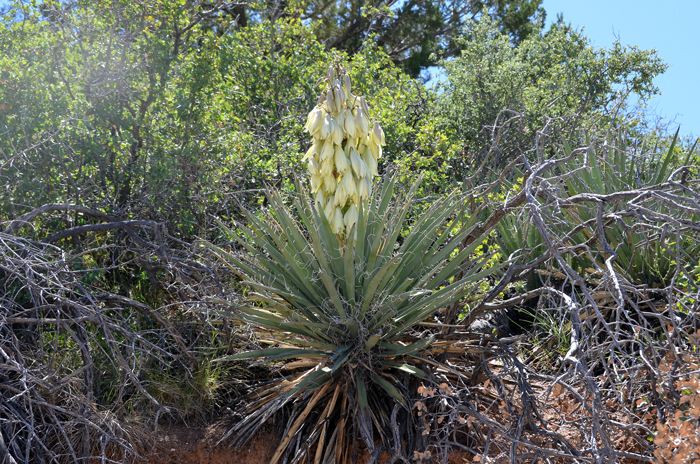Yucca baccata, Banana Yucca





Scientific Name: Yucca baccata
Common Name: Banana Yucca
Also Called: Banana Yucca, Blue Yucca, Datil, Datil Yucca, Fleshy-fruited Yucca, Spanish Bayonet (Spanish: Dátil)
Family: Agavaceae, Agave or Century Plant Family (Reclassified to Asparagaceae)
Synonyms: (Yucca baccata var. baccata, Yucca baccata var. vespertina, Yucca confinis, Yucca vespertina, Yucca arizonica)
Status: Native
Duration: Perennial
Size: Up to 30 feet or so.
Growth Form: Shrub, subshrub; growth form variable - stemless or with multiple stems in clumps and short ascending stems; (acaulescent or short caulescent); forming colonies of rosettes.
Leaves: Green, bluish green; rigid, often twisted, margins brown and with coarse broad fibers (filiferous), curling, spine-tipped; leaves reaching up to 30 inches high and twice as wide.
Flower Color: Cream, whitish-cream, may be tinged with purple; flowers showy, monecious, hanging or drooping; petals and sepals similar (tepals); inflorescence up to 3 feet or more high tall, flowering stalk often within the leaves; flowers paniculate; fruit indehiscent, succulent.
Flowering Season: April to July.
Elevation: 1,200 to 7,500 feet.
Habitat Preferences: Dry rocky or sandy soils, rocky hillsides, mesas, desert grasslands, pinyon-juniper and oak woodlands.
Recorded Range: Yucca baccata has a broad distribution throughout the southwestern United States. It is native to AZ, CA, CO, NM, NV, TX, UT. Arizona is the center of greatest distribution for this Yucca and population densities in other states is greatest in proximity to Arizona. Populations in Texas along are found in the western boundary near New Mexico. It is also found in large numbers in northwest Mexico (Chihuahua, Sonora).
North America & US County Distribution Map for Yucca baccata.
U.S. Weed Information: No information available.
Invasive/Noxious Weed Information: No information available.
Wetland Indicator: No information available.
Threatened/Endangered Information: In North America Yucca baccata is listed as "Salvage Restricted" and "Harvest Restricted" by the state of Arizona; in Nevada Yucca baccata var. baccata is "Protected" as a Cactus, Yucca, or Christmas Tree.
In the Southwestern United States: Arizona has 8 species of Yucca, California has 3 species, Nevada has 5 species, New Mexico has 10 species, Texas has 18 species, Utah has 7 species. All data is approximate and subject to taxonomic changes.
There are 2 varieties in Yucca baccata in Flora of North America;
Yucca baccata var. baccata, Banana Yucca, Blue Yucca, Datil (AZ, CA, CO, NM, NV, TX, UT);
Yucca baccata var. brevifolia, Thornber yucca (AZ, NM).
Comments: Yucca baccata is one of the most important resources for southwestern North American indigenous peoples. Almost all parts of the Banana Yuccas are used including stalks, leaves, flowers, fruits and roots. The plant provides a food source that includes beverages, cakes, sauces, relishes, preserves and porridges; materials are also obtained and used for development of sporting items, ceremonial items, construction of dwellings, tools and more.
Banana Yucca is suitable and available for desert and upland landscaping. Needs good drainage. Consideration for size is important as plants can grow to 30 feet tall with leaves up to 30 inches high and 60 inches wide.
Banana Yucca is often a dominant or co-dominant species in Sonoran desert communities.
This may be related in part to its ability to grow back from rhizomes and basal stems below the ground following range fires.
In Southwestern Desert Flora also see: Blue Yucca, Yucca rigida; Beaked Yucca, Yucca rostrata; Eve's Needle, Yucca faxoniana; Joshua Tree, Yucca brevifolia and Soaptree Yucca, Yucca elata.
Native American Ethnobotany: Yucca baccata has been used for food, beverages, desserts and materials for tools and baskets by southwestern American indigenous peoples.
Acoma, Food, Beverage; Dried fruits dissolved in water to make a drink.
Acoma Food, Bread & Cake; Fruits baked, boiled, dried, rolled into loaves and stored for winter use.
Apache Fiber, Basketry; Leaves used for the main portion of the baskets.
Apache Food, Bread & Cake; Fruit roasted, pulp made into cakes and stored.
Apache, White Mountain Other, Soap; Roots used for soap.
Havasupai Fiber, Cordage; Leaf fiber braided into ropes. The leaves contained a good fiber. The terminal spine and a section of the back of the leaf were removed and pounded to free this fiber from the fleshy portion of the leaf. The fiber was often braided into rope, three to six ply, from twelve to thirty feet long that were used for many purposes, including handling horses.
Hopi Fiber, Basketry; Leaves occasionally used in basketry.
Isleta Food, Winter Use Food; Sun dried fruit used for winter storage.
See ethno-botanical uses at Native American Ethnobotany, University of Michigan, Dearborn.

